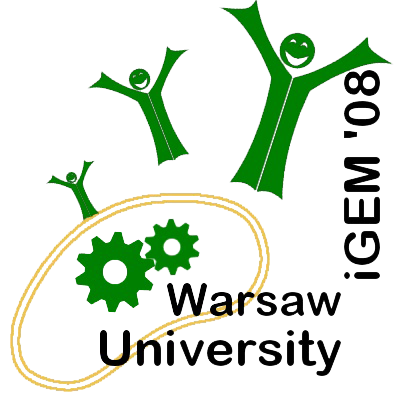Team:Warsaw/Project
From 2008.igem.org

| |
Contents |
Abstract
Our team is planning to develop two connected devices. The first device will introduce mutations to a defined region of plasmid in E. coli cells (level of mutations in the rest of bacterial genome should be near to background). We’ll try to achieve this using human protein AID (Activation Induced Deaminase). It acts on single-stranded DNA causing C U substitutions. This activity causes point mutations and activation of various DNA repair systems potentially including error-prone DNA repair systems. Site-specific in vivo DNA mutagenesis device can be used to produce proteins with new activities. In this case proper selection pressure must be applied. Our second device will be used to create proper selection conditions. It will use beta-lactamase split into two complementing domains anchored on E. coli cell surface and culture medium containing ampicillin to promote survival of clones expressing desired phenotype and ensure death of others. One beta-lactamase domain and protein which interactors we will be looking for will be bound to cell membrane. The other domain will be connected with ligand and added to culture medium. Interaction between protein and ligand will cause complementation of beta-lactamase domains and ampicillin-resistant phenotype. Connection of those two devices may allow to build machine screening for strongly interacting pairs of proteins i.e. antibody and antigen.
Project Details
Our first device will introduce mutations to the specific fragment of plasmid in E. coli cells. We want to limit mutagenesis to particular sequence and avoid mutations in bacterial chromosome. The basic part of this device is human protein AID, which activity is crucial for maturation of proteins in lymphocytes. AID acts on single-stranded DNA during transcription causing conversion of cytosine to uracil. This leads to point mutations. Aid gene has been already expressed in E. coli and caused increased mutation rate of some highly transcribed loci. The first construct we want to prepare – A plasmid will encode aid gene under arabinose-inducible promoter (PBAD). AID expressed from this plasmid should act on highly transcribed loci. Sequences expressed from T7 promoter have one of the highest transcription levels. That’s why our next construct will carry transcription (plasmid A+T7) or translation (plasmid A=T7) fusion between AID and T7 polymerase. Some authors suggest that AID may act as oligomer, so we will create construct encoding transcription fusion between AID and AID-T7 translation fusion (plasmid A+A=T7). In that case fusion protein AID-polT7 may recruit free molecules of AID. Control plasmid T7, carrying only T7 polymerase gene, will be also created.
To test usefulness of constructs containing various variants of AID protein some reporter system must be created. In our case it will be based on pZC plasmid - the one-copy minireplicon of F plasmid. pZC encodes alpha fragment of beta-galactosidase under two promoters (T7 and lac). Using pZC we will be able to assess mutation level of sequence encoding reporter gene (mutations will result in white colonies). We expect mostly C T substitutions but we hope that error-prone DNA repair systems will be activated causing insertion of random nucleotide into mutation site. Results of blue-white mutation screening will be confirmed by sequencing of reporter gene. We also have to determine level of mutations occurring on chromosome. One of the simplest tests is to determine the frequency of mutations resulting in rifampicin-resistant phenotype. Optimal culture and induction of mutator system genes expression conditions need to be found. If level of mutations will be too low, we’ll use bacterial strains with damaged DNA repair systems.
The task of our second device is to select proteins interacting on the surface of E. coli cells. Selection will be based on complementation of beta-lactamase fragments. Complementation occurs only when the fragments are in close proximity and it is not spontaneous. Connecting beta-lactamase fragments to two interacting proteins will allow complementation and will make cells ampicillin-resistant. We want to connect one beta-lactamase fragment to outer membrane anchor protein and add the other fragment connected with ligand protein to culture medium. In ampicillin-containing medium cells expressing a protein that stronger binds to ligand will have selection advantage over others. It will allow screening of libraries encoding antibody fragments or receptor proteins to select best binding clones for specific ligand. But our main aim is connecting this device with previously described one to create variance and simultaneously select cells expressing desired phenotype i.e. cells expressing antibody fragments with high affinity to given antigen.
On this stage numerous control and test constructs will be created and optimal screening device will be selected. The basic part of most constructs will be outer membrane anchor from OmpA protein. Other parts include alpha and omega beta-lactamase fragments and A and Z proteins. A and Z are small strongly interacting proteins. Usage of A and Z protein fused with receptor and ligand protein will ensure their close proximity and allow close contact of beta-lactamase fragments. Interaction of A and Z proteins will also help us in assessing ampicillin resistance level given by two complementing beta-lactamase fragments. In final stage of our project constructs for both receptor and ligand protein overexpression and purification will be created.
The Experiments
See [http://openwetware.org/wiki/IGEM:UW/2008/Notebook/iGEM_UW_Team Lab Notebook]
Results
None yet :-)
| Home | The Team | The Project | [http://openwetware.org/wiki/IGEM:UW/2008/Notebook/iGEM_UW_Team Notebook] |
|---|
 "
"